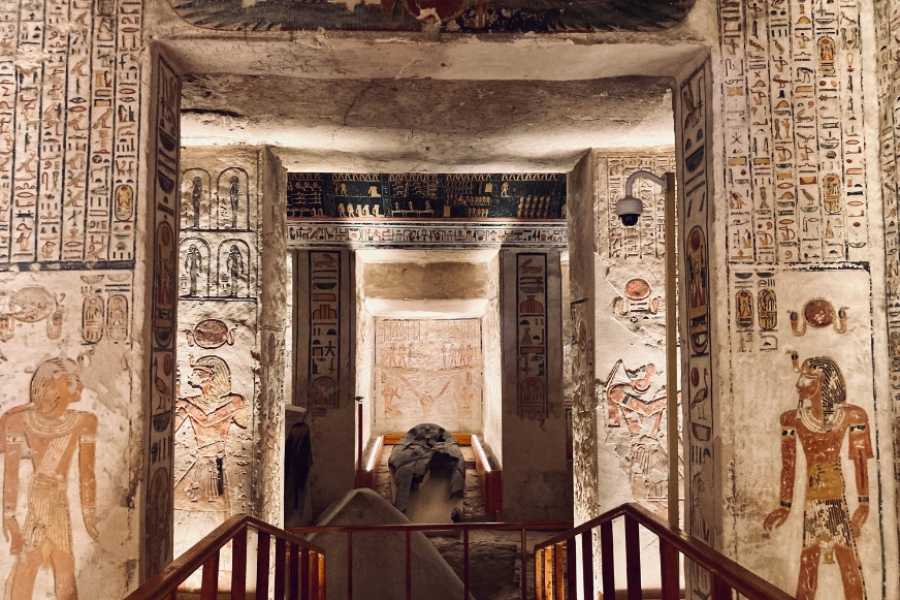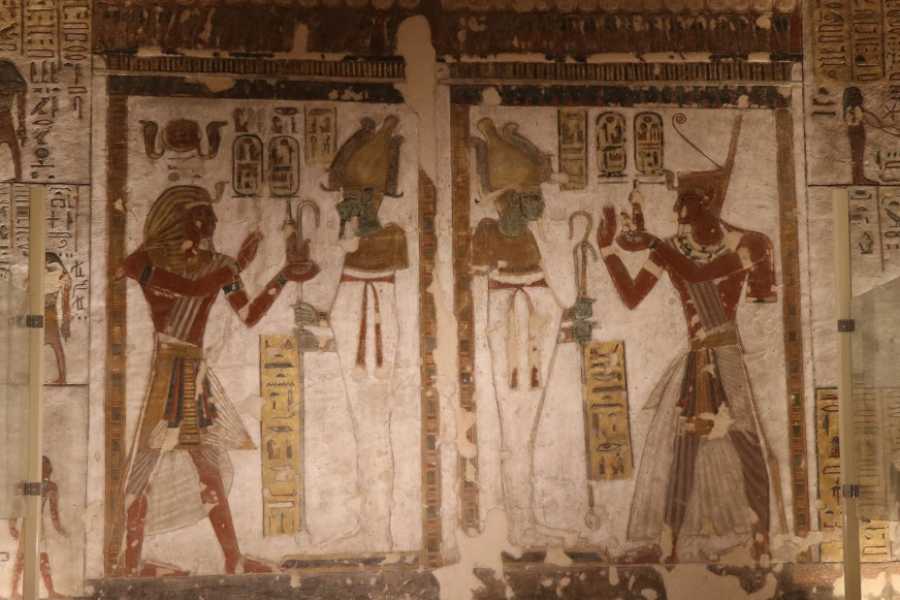Guided Tour to Valley of the kings from Luxor
Desde USD 42
+5 Opciones adicionales
Explore Valley of the Kings with 4 Hours Private Guided Tour from Luxor
After breakfast, meet our Guide and our driver at the reception of your hotel, Enjoy a Private Guided Tour to Valley of the Kings
The Valley of the Kings :
Once called the great Place of the Truth,this valley is called now the Valley of the Kings, It is a Majestic domain of the Pharaohs who once lay in great stone Sarcophagi, awaiting immortality. The isolated valley behind Deir el Bahri is dominated by the Pyramid-Shaped Mountain Peak. Each Ticket covers only 3 tombs- You can ask your guide which tombs are open and which one you wish to visit.
In The Valley of the Kings, you will visit:
The Tomb of Rameses IV:
This Tomb is the second tomb on the right as you enter the Valley of the Kings, Its whereabouts were known even by the Ptolemies, as is evident from Graffiti dating back to 278 Bc that can be seen on the walls, Only recently opened to the Public. It`s not one of the finest Tombs. Many paintings in the burial chamber have deteriorated, Although the painting of the goddess Nut stretched across the blue ceiling, is still in Good condition. The mummy of Rameses IV was Found in the tomb of Amenhotep II.
The Tomb of Merneptah :
Because Ramesses II Lived so long.12 of his sons died before he did. It was his 13th son Merneptah (1213-1203 B.C) who Finally became the Pharaoh in his 60s. His tomb has been open since antiquity and has its share of Classical Graffiti, The reliefs of Isis and her sister Nephtis, the Guardian of Coffins, adorn the entrance of this tomb, Although there is a certain amount of flood damage on the lower portion of the walls of the tunnel-like. Long the scenes feature the litany of Ra. The book of Amduat and the book of the gate. The Pharoah was originally buried inside four stone Sarcophagi, Three of granite( The lid of the second still in Situ ), and the fourth innermost Sarcophagus of the Alabaster. His mummy was removed from antiquities and was found in Amenhotep II`s( No-35 - It is now displayed in the Egyptian museum.
The Tomb of Rameses III:
King Ramses III was the second ruler of the Twentieth Dynasty and the last of the great pharaohs. He was the son of Setnakht and ruled Egypt for 31 years. Before he died, there was a plot to kill him, involving several members of his household, including one of his minor wives, Queen Tiy. This was an effort to help her son take the throne. The details of this conspiracy are depicted on the walls of his mortuary temple at Madinat Habu. Setnakht started the tomb but left it to be buried in KV14. His son, Ramses III, continued the work on KV11. James Bruce was the first European to enter this tomb in 1768 and was impressed by the painted figures of two blind harpists, naming it the Tomb of the Harpists. Today, the Tomb of Ramses III is one of the most popular sites in the Valley of the Kings, known for its stunning reliefs and paintings. Tomb KV11, located in the main valley, was initially begun by Setnakhte but was left unfinished after it accidentally connected to the earlier tomb of Amenmesse (KV10). Setnakhte was buried in KV14.
If you wish to add extra tickets to more the 3 Tombs- we do recommend those tombs.
The Tomb of Rameses IX:
Ramses IX was the eighth king of the Twentieth Dynasty during Ancient Egypt's New Kingdom. He brought stability back to the nation after the turmoil that followed Ramses VI's death. Papyrus Turin states that Ramses IX ruled for 18 years and 4 months, passing away in the 19th year of his reign. His tomb, known as KV 6, was the first to be opened since ancient times, and many inscriptions from past visitors can be found inside. This tomb was the last royal one excavated in the Valley of the Kings in Luxor. Its design is simple and was influenced by the earlier Tomb of Ramses III (KV 11). It also shares many decorative and archaeological features with the Tomb of Ramses VI (KV 9). Although the tomb's layout is compact, it is of average size for royal tombs, with the widest gates and corridors in the Valley. The Tomb of Ramses IX (1126-1108 BC) includes a long, sloping corridor, a large antechamber adorned with animals, serpents, and demons, followed by a pillared hall and a short hallway leading to the burial chamber. The ceiling features the sky goddess Nut, surrounded by sacred boats filled with stars. Just before the staircase to the burial chamber, there are cartouche symbols of Ramses IX.
The Tomb of Rameses VII (KV 1)
The small Tomb of Ramesses VI I (KV 1) is situated in the Valley of the Kings on the Western Bank of Luxor, not far from the road. A Greek inscription indicates that this tomb was known and open to visitors during the Greek era. It was first noted by 19th-century explorers like Wilkinson, Lane, and Hay. Work on the tomb started in 1905 and 1906. Its layout is typical of late Ramesside tombs. The artwork on the walls offers fascinating insights into the Golden Age of the Pharaohs and ancient Egypt. To enter the tomb, visitors go up a passage that leads to the entrance, which features a solar disc surrounded by images of the King and several goddesses. Inside, there is a corridor adorned with scenes of the King before various deities, along with illustrations from the Book of Gates and the Book of Caverns. Sadly, the corridor's walls and ceiling have some cracks. Nearby is the Burial Chamber of Ramesses VII, which is decorated with scenes from the Book of the Earth.
The Tombs With extra Fees Are (TOMB OF RAMSES VI & The Tomb of Seti I & The Tomb of Tutankhamun )
1. TOMB OF RAMSES VI (NO 9)
The early excavation of this tomb forestalled the discovery of Tutankhamun's much smaller, earlier tomb that lay below it. The tomb was actually begun for the ephemeral Ramses V (1147-1143 BC) and continued by Ramses VI (1143-1136 BC), with both pharaohs apparently buried here. Its decoration has an emphasis on astronomical scenes and texts, which include the Book of Gates, Book of Caverns, Books of the Heavens, and, for the first time, Book of the Earth. A superb double image of Nut decorates the ceiling of the burial chamber, where only part of the sarcophagi remains. Following the tomb's ransacking a mere 20 years after burial, the mummies of both Ramses V and Ramses VI were moved to Amenhotep II's tomb where they were found in 1898 and taken to Cairo.
Optional Tombs of the Tomb of
2. The Tomb of Seti I (NO 17):
Discovered in 1817, the Tomb of Seti I (1294-1279 BC) is more than 120m long, making it one of the largest in the valley. Part of its superb painted reliefs of Seti with Hathor are now in the Louvre and Turin museums, while Seti's alabaster sarcophagus was brought to London. The British Museum refused to pay the asking price, so it went to a private collector, Sir John Soane, in the basement of whose London house-turned-museum it can still be seen. Seti's mummy had been moved in antiquity and was found in the Deir al-Bahri mummy cache, which is now in the Egyptian Museum. Despite the pilfering, this is in many people's opinion the most beautifully decorated tomb in the valley. The first part of the pharaoh's burial chamber is decorated with texts from the Book of Gates, the Book of the Divine Cow, and the Book of Amduat
3. The Tomb of Tutankhamun :
Tutankhamun was laid to rest in a small tomb (KV62) that seemed too modest for a king. His death might have been sudden, preventing the completion of a larger tomb, so he was buried in one meant for another. Inside, four gilded wooden shrines surrounded his sarcophagus. Today, the only item left in King Tutankhamun's burial chamber is his quartzite sarcophagus, which holds a golden coffin that contains the young pharaoh's mummy. Although the chamber appears sparse, it actually holds Egypt's most significant treasures: Tutankhamun’s mummy, his solid gold coffin, and his famous death mask. The limited space between the large blue and gold shrine and the northern wall held boat oars and an Imiut Fetish, a symbol of Anubis, arranged neatly. Unlike other rooms filled with numerous items, this burial chamber showcased elegance with its wall reliefs and the brilliant gold surrounding the two additional shrines and Tutankhamun ’s sarcophagus.

Aspectos importantes
- Explore the valley of the Kings
- Private guided Tour with a Qualified Egyptologist guide
- Visit three different tombs
- Skip the Line
- Qualified Egyptologist guide
Hotel pick-up and drop-off
Transport by air-conditioned vehicle
Entrance fees
- Any extras not mentioned in the program
- Tipping
- Hat
- Camera
- Sunglasses
Ruta
- Luxor






